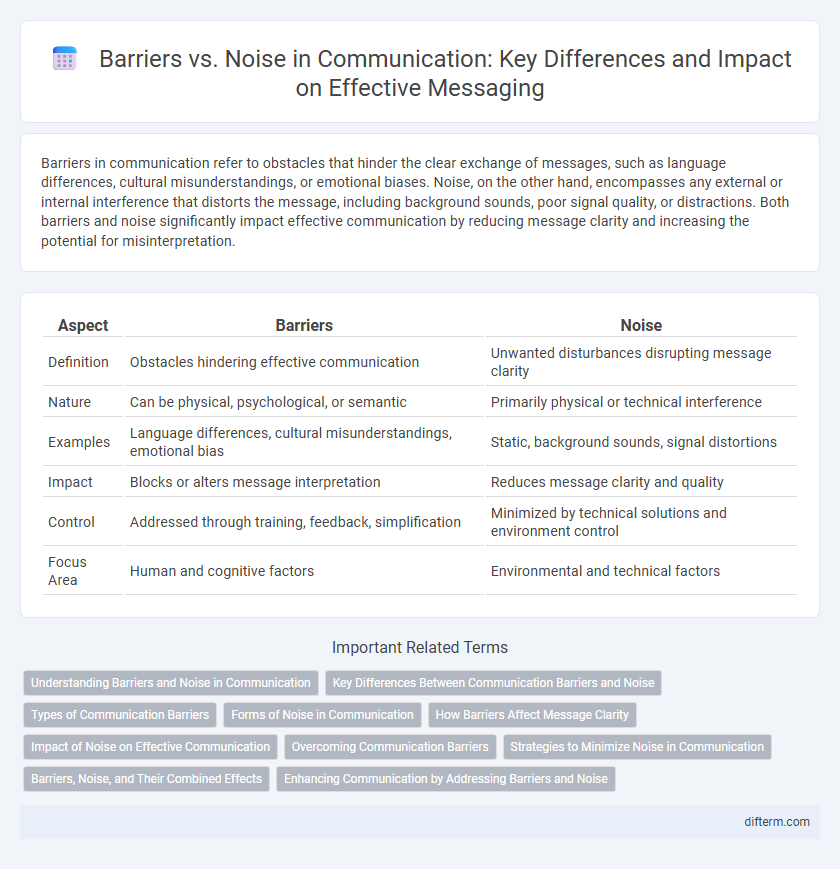Barriers in communication refer to obstacles that hinder the clear exchange of messages, such as language differences, cultural misunderstandings, or emotional biases. Noise, on the other hand, encompasses any external or internal interference that distorts the message, including background sounds, poor signal quality, or distractions. Both barriers and noise significantly impact effective communication by reducing message clarity and increasing the potential for misinterpretation.
Table of Comparison
| Aspect | Barriers | Noise |
|---|---|---|
| Definition | Obstacles hindering effective communication | Unwanted disturbances disrupting message clarity |
| Nature | Can be physical, psychological, or semantic | Primarily physical or technical interference |
| Examples | Language differences, cultural misunderstandings, emotional bias | Static, background sounds, signal distortions |
| Impact | Blocks or alters message interpretation | Reduces message clarity and quality |
| Control | Addressed through training, feedback, simplification | Minimized by technical solutions and environment control |
| Focus Area | Human and cognitive factors | Environmental and technical factors |
Understanding Barriers and Noise in Communication
Barriers in communication refer to obstacles that distort or block the transfer of information, including physical, psychological, and semantic factors. Noise represents any external or internal interference that disrupts message clarity, such as background sounds, technical disruptions, or cognitive distractions. Recognizing the distinct roles of barriers and noise is essential for enhancing effective communication and minimizing misunderstandings.
Key Differences Between Communication Barriers and Noise
Communication barriers are obstacles that hinder the effective understanding and transmission of messages, including language differences, cultural misunderstandings, and psychological factors. Noise refers specifically to any external or internal interference that distorts or blocks the message during the communication process, such as background sounds, technical issues, or distractions. The key difference lies in barriers being broader systemic issues affecting communication, while noise represents immediate, often physical disturbances impacting message clarity.
Types of Communication Barriers
Communication barriers include physical obstacles, language differences, psychological factors, and cultural misunderstandings. These barriers hinder message clarity and result in misinterpretations or incomplete information transfer. Identifying and addressing these types enhances communication effectiveness in personal and professional contexts.
Forms of Noise in Communication
Forms of noise in communication include physical noise such as background sounds or poor signal quality, psychological noise like stress or preconceived notions affecting message interpretation, and semantic noise involving language differences or ambiguous vocabulary. These disruptions hinder the clarity and effectiveness of the transmitted message between sender and receiver. Understanding and mitigating these types of noise is essential to improving communicative accuracy and reducing misunderstandings.
How Barriers Affect Message Clarity
Barriers in communication distort or block the intended message, reducing overall clarity and understanding. Psychological barriers such as biases, emotional states, and cultural differences often lead to misinterpretation of the message content. Physical barriers, including environmental noise and technical issues, further degrade the signal, causing information loss and confusion in communication channels.
Impact of Noise on Effective Communication
Noise disrupts the clarity and accuracy of messages, causing misunderstandings and information loss in communication processes. It interferes with the sender's signal and receiver's interpretation, reducing message effectiveness and increasing errors. Persistent noise leads to decreased engagement, lower trust, and impaired decision-making in communication channels.
Overcoming Communication Barriers
Overcoming communication barriers requires identifying and addressing both physical and psychological noise that disrupt message clarity. Techniques such as active listening, feedback loops, and simplifying language enhance understanding and minimize distortion. Leveraging technology tools can also reduce environmental noise, ensuring effective information exchange.
Strategies to Minimize Noise in Communication
Effective strategies to minimize noise in communication include selecting appropriate channels that suit the message type and audience, ensuring clear, concise language to reduce misunderstandings, and implementing feedback mechanisms to confirm message accuracy. Environmental controls such as reducing physical distractions, optimizing acoustic settings, and using noise-canceling technology further enhance message clarity. Training communicators in active listening and empathy also helps identify and address potential interference early, improving overall communication effectiveness.
Barriers, Noise, and Their Combined Effects
Barriers in communication, such as physical distance, language differences, and psychological biases, obstruct the clear exchange of messages, reducing understanding and increasing misinterpretation. Noise encompasses any external or internal disturbances--like background sounds, technical glitches, or cognitive distractions--that interfere with message transmission and reception. The combined effects of barriers and noise intensify communication breakdowns, causing message distortion, loss of information, and decreased interaction effectiveness in personal and professional settings.
Enhancing Communication by Addressing Barriers and Noise
Effective communication requires identifying and minimizing barriers such as language differences, cultural misunderstandings, and emotional biases that distort message clarity. Noise, whether physical like background sounds or psychological like distractions, interferes with accurate reception and interpretation of information. Implementing active listening, feedback loops, and technology tools reduces the impact of barriers and noise, enhancing message clarity and overall communication effectiveness.
Barriers vs Noise Infographic

 difterm.com
difterm.com